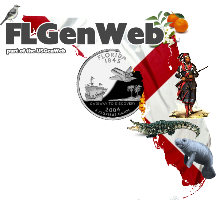.png)
 ®
®

|
DUVAL COUNTY NATIVE AMERICANS IN DUVAL COUNTY Home | Archives | Biographies | Cemeteries | Cities & Towns | Events | Funeral Homes | History | Hospitals | Libraries | Links | MapsNative American | Newspapers | Obituaries | Vital Records | Volunteer | What's New County Coordinator: Available
|
|
Ossachite, The Timucua Metropolis in Jacksonville's Past Timucuan Villages The Mocama: New Name for an Old People Florida Native American Project - Indigenous People of Florida Florida of the Indians Wikipedia: -- Timuca The Timucua were a Native American people who lived in Northeast and North Central Florida and southeast Georgia. They were the largest indigenous group in that area and consisted of about 35 chiefdoms, many leading thousands of people. The various groups of Timucua spoke several dialects of the Timucua language. At the time of European contact, Timucuan speakers occupied about 19,200 square miles (50,000 km2) in the present-day states of Florida and Georgia, with an estimated population of 200,000. Milanich notes that the population density calculated from those figures, 10.4 per square mile (4.0/km2) is close to the population densities calculated by other authors for the Bahamas and for Hispaniola at the time of first European contact. The territory occupied by Timucua speakers stretched from the Altamaha River and Cumberland Island in present-day Georgia as far south as Lake George in central Florida, and from the Atlantic Ocean west to the Aucilla River in the Florida Panhandle, though it reached the Gulf of Mexico at no more than a couple of points. The name "Timucua" (recorded by the French as Thimogona but this is likely a misprint for Thimogoua) came from the exonym used by the Saturiwa (of what is now Jacksonville) to refer to the Utina, another group to the west of the St. Johns River. The Spanish came to use the term more broadly for other peoples in the area. Eventually it became the common term for all peoples who spoke what is known as Timucuan. While alliances and confederacies arose between the chiefdoms from time to time, the Timucua were never organized into a single political unit. The various groups of Timucua speakers practiced several different cultural traditions. The people suffered severely from the introduction of Eurasian infectious diseases, to which they had no immunity. By 1595, their population was estimated to have been reduced from 200,000 to 50,000 and thirteen chiefdoms remained. By 1700, the population of the tribe had been reduced to an estimated 1,000. Warfare against them by the English colonists and native allies, and the slave trade completed their extinction as a tribe soon after the turn of the 18th century. * * * Tribes. The Timucua were divided into a number of different tribes or chiefdoms, each of which spoke one of the nine or ten dialects of the Timucua language. The tribes can be placed into eastern and western groups. The Eastern Timucua were located along the Atlantic coast and on the Sea Islands of northern Florida and southeastern Georgia; along the St. Johns River and its tributaries; and among the rivers, swamps and associated inland forests in southeastern Georgia, possibly including the Okefenokee Swamp. They usually lived in villages close to waterways, participated in the St. Johns culture or in unnamed cultures related to the Wilmington-Savannah culture, and were more focused on exploiting the resources of marine and wetland environments. All of the known Eastern Timucua tribes were incorporated into the Spanish mission system starting in the late 16th century. However, the Acuera appear to have maintained a "parallel" religious system, with traditional shamans practicing openly with numerous followers even at the height of missionization. After the Timucuan Rebellion of 1656, the Acuera left the mission system and appear to have remained in their traditional territory, and to have maintained their traditional religious and cultural practices through the beginning of the eighteenth century. They are the only known Timucuan chiefdom, among all the Timucua, to have done so. * * * See Wikipedia link above for more information. |